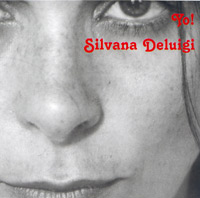
CD 9158-2 |
Silvana Deluigi
"YO!"
Silvana Deluigi (vocal) with:
piano: Pablo Ziegler, Gustavo Beytelmann, Osvaldo Calo
violin: Fernando Suarez Paz, Alfredo Triff
bass: Renaud Garcia Fons; Horacio Hurtado; Andy Gonzalez
el-bass: Steve Swallow; guitar: Haracio Malvicino
percussion: Robby Amen; bandoneon: Walter Castro; Horacio Romo
produced by Kip Hanrahan
1. La Cumparsita 3:39 2. Cuesta abajo 3:56
3. Sonamos el Tango 4:30 4. Tangologie 3:54
5. Discepolin 3:22 6. Mariana, Mariana 3:33 7. La Guitarra 4:12
8. A la Una yo Naci 1:19 9. Milonga for Three 6:12
10. Maquillaje 3:43 11. Te amo 5:58
12. Gorrion de Hoy (intro) 1:07 13. Sobre la Tierra 2:51
14. Me Vuelves Loca 2:48 15. Milonga en el Viento 5:31
16. Gorrion de Hoy (finale) 0:49
Recorded 2001/2002 in Paris, Buenos Aires and New York
|
|
|
Silvana Delugi was born in Buenos Aires and grew up in the tradition of classical tango.
While still at school, she already studies singing at the music conservatory in Buenos Aires. Having finished school, she studies acting.
In 1982, she performs in different musicals, like "Romeo and Juliet" and the "West Side Story" (role of Maria). Moves to Paris in 1984. In 1985, first tango interpretations. The bandoneon star Juan-José Mosalini discovers her. First solo concerts in 1986 in the legendary Parisian Tango-Club "Les Trottoirs de Buenos Aires". In 1988, first tango show, "Blue Tango". In 1989, main role in the TV-film "Tanguera" (produced by ARTE and WDR).
Recording and performs with Juan José Mosalini,Luis Di Matteo, Osvaldo Calo, Renaud Garcia Fons, Jean-Louis Matinier a.o. also records with pop stars like Caetano Veloso and Sting.
Like the late Astor Piazzolla- one of her main influences- Silvana Deluigi is a very risk-taking and progressive tango artist. The modern Tanguera Silvana Deluigi reflects the history of tango, song by song, from a woman's point of view. "This record is one of shear beauty. The music is passionate, romantic and in some ways different in a very nice way than any other Kip project to date…accessable and frightfully close to perfection ."
Kip Hanrahan:
"So Silvana walks on stage and everything else kind of falls away. Yeah, the lighting, the proportions of the stage, the distance between the listener, the observer, and the singer, actress, everything. I've seen it, I've been there. If she walks into the frame of the movie, everything else becomes a distant, shaded, background : the other actors, the lighting : and, as only in others of the rarest cases of charisma, the framing actually dissipates. Again, I've seen it.
On stage, the other players are still there, it's still the context, the bandoneon, the stern faces in their places, but it's only a context in which Silvana's music, through which Silvana, that tango, can be accessed. She could go to the front of the stage (say, if the sound system fell apart, and the musicians stopped...) and kneel on the edge of it, and sing a capella, and an audience of three thousand would push to the front, not just to hear her fantastic voice, but to be closer to the perfume, the scent of that tango.
We all know that the tango's not really a music. It's the intense, dark glow and romance surrounding a player. Expectations of a history, or of a danger.. I guess that's where the danger reference comes in. The macho Tango around Astor, or Goyeneche or (still) around Gardel. But the female tango is just as intense. Inverse, but just as strong a scent, just as dark. It's the female confidence of that tango around Silvana that makes the surroundings dissipate.And the voice, of course : it's not just the perfect intonation or gorgeous tone, it's the swing behind the anticipation, it's that sound and swagger of sex made audible.
Maybe restating the obvious, what made Astor the king of the tango wasn't really the formal innovations, the layers of dark and light and counterpoint, and shifting, viscerally breathtaking, chordal changes and complex references in his compositions. It was the fact that he had the guts and vision and defiance and fight to change the music he inherited into something that described the darkness inside himself.
What made Malvi, Pablo, Suarez Paz and Console the best tango band of our time wasn't their awesome command of their instruments (although) dare you to name any other musicians with as deep technical skills), but it was the way they took Astor's music, and dangers, and arrogantly made it so naturally parts of their own personal swaggers. And what makes Silvana the Queen of the Tango has, of course, even less to do with compositional or instrumental innovations than in Astor's case. It has to do with the darkness that she arrogantly surrounds herself with, and with that pause, and that sexual anticipation, y'know, that tango.
Anyway, all that shit about the tango dying, or being antiquated, or whatever. There's really nothing in the tango that can be superseded. There's never going to be a time when we won't be able to feel the dark glow, and not be able to smell the sex in the danger around Silvana.
Yeah, the real tango."
|